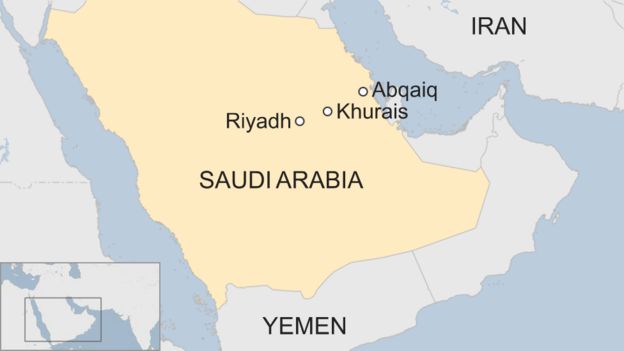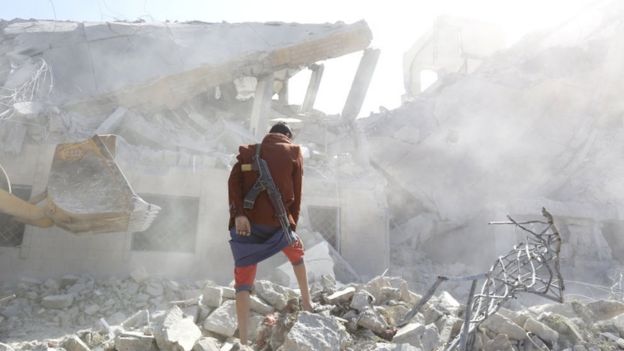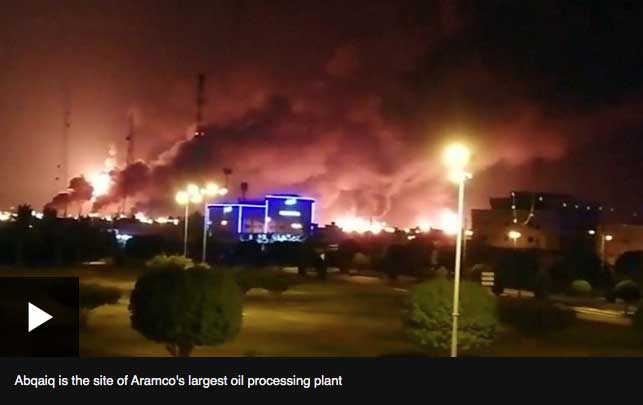Drone attacks have set alight two major oil facilities run by the state-owned company Aramco in Saudi Arabia, state media say.
Footage showed a huge blaze at Abqaiq, site of Aramco's largest oil processing plant, while a second drone attack started fires in the Khurais oilfield.
The fires are now under control at both facilities, state media said.
A spokesman for the Iran-aligned Houthi group in Yemen said it had deployed 10 drones in the attacks.
The military spokesman, Yahya Sarea, told al-Masirah TV, which is owned by the Houthi movement and is based in Beirut, that further attacks could be expected in the future.
He said Saturday's attack was one of the biggest operations the Houthi forces had undertaken inside Saudi Arabia and was carried out in "co-operation with the honourable people inside the kingdom".
Saudi officials have not yet commented on who they think is behind the attacks.
"At 04:00 (01:00 GMT), the industrial security teams of Aramco started dealing with fires at two of its facilities in Abqaiq and Khurais as a result of... drones," the official Saudi Press Agency reported.
"The two fires have been controlled."

Abqaiq is about 60km (37 miles) south-west of Dhahran in Saudi Arabia's Eastern Province, while Khurais, some 200km further south-west, has the country's second largest oilfield.
Saudi security forces foiled an attempt by al-Qaeda to attack the Abqaiq facility with suicide bombers in 2006.
Markets await news from key facilities
Analysis by BBC business correspondent Katie Prescott
Aramco ranks as the world's largest oil business and these facilities are significant.
The Khurais oilfield produces about 1% of the world's oil and Abqaiq is the company's largest facility - with the capacity to process 7% of the global supply. Even a brief or partial disruption could affect the company, given their size.
But whether this will have an impact on the oil price come Monday will depend on just how extensive the damage is. Markets now have the weekend to digest information from Aramco and assess the long-term impact.
According to Richard Mallinson, geopolitical analyst at Energy Aspects, any reaction on Monday morning is likely to be muted, as markets are less worried about supply than demand at the moment, due to slower global economic growth and the ongoing trade war between the US and China.
As Aramco is preparing for its much-anticipated initial public offering (IPO), it will be mindful that it needs to have communicated clearly with the market about what has happened.
The IPO is part of a reform package led by King Salman's son, Crown Prince Mohammed bin Salman, to reduce the economy's reliance on oil.
Who carried out the attacks?
The Iran-aligned Houthi rebel movement has been fighting the Yemeni government and a Saudi-led coalition.
Yemen has been at war since 2015, when President Abdrabbuh Mansour Hadi was forced to flee the capital Sanaa by the Houthis. Saudi Arabia backs President Hadi, and has led a coalition of regional countries against the rebels.
- Yemen conflict explained in 400 words
- Why is there a war in Yemen?
- Yemen war: Has anything been achieved?
The coalition launches air strikes almost every day, while the Houthis often fire missiles into Saudi Arabia.
Mr Sarea, the Houthi group's military spokesman, told al-Masirah that operations against Saudi targets would "only grow wider and will be more painful than before, so long as their aggression and blockade continues".

Houthi fighters were blamed for drone attacks on the Shaybah natural gas liquefaction facility last month and on other oil facilities in May.
There have been other sources of tension in the region, often stemming from the rivalry between Saudi Arabia and Iran.
Saudi Arabia and the US both blamed Iran for attacks in the Gulf on two oil tankers in June and July, allegations Tehran denied.
In May, four tankers, two of them Saudi-flagged, were damaged by explosions within the UAE's territorial waters in the Gulf of Oman.
Saudi Arabia and then US National Security Adviser John Bolton blamed Iran. Tehran said the accusations were "ridiculous".
Tension in the vital shipping lanes worsened when Iran shot down a US surveillance drone over the Strait of Hormuz in June, leading a month later to the Pentagon announcing the deployment of US troops to Saudi Arabia.
SOURCE: BBC



